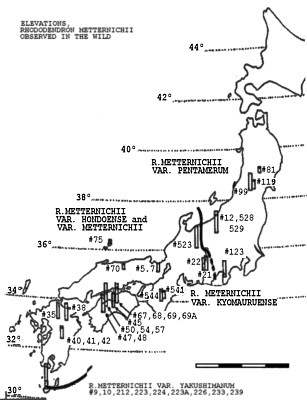QBARS - v26n3 Elevations Where R. metternichii Is Found
Elevations Where
R. Metternichii
Is Found
Frank Doleshy, Seattle, Wash.
Republication rights reserved by the author.

|
A trip to Japan, for Mrs. Doleshy and me, is always at least partially a search for Rhododendron metternichii . The many other Rhododendrons are interesting and beautiful. For example, nothing could be more challenging than to explain the distribution of R. brachycarpum , nothing could be more delicate than R. tashiroi covered with butterfly-like flowers, and nothing more staunch than the Yakushima Azaleas with trunks a foot thick, standing up straight where the Junipers and evergreen Rhododendrons creep flat on the ground. Yet none of these quite give us the supercharged excitement of seeing the tawny indumentum and familiar growth habit of R. metternichii.
Best of all, this plant has a very obstinate and uncooperative attitude toward those people who would like to put everything in its proper little pigeonhole, complete with clone name and rating. We share the attitude of the plant and therefore get along much better in the wild than we do with the pigeon holers.
One outstanding feature is the lack of correlation between latitude and the elevations where this species is found. Such a pattern (or lack of pattern) seems unreasonable and nearly unbelievable to many people. Therefore we present this map.
The species extends almost 900 miles along Japan's length, from Mitake, in northern Honshu, to Yakushima, 50 miles out in the ocean from the southernmost main island of Kyushu. The far-northern race is R. metternichii var. pentamerum (often still called " R. degronianum ") with 5-part flowers and a usually rather compact habit of growth. Our observations, and all that we've read and heard, indicate that this variety is only found to the north of the great rift which separates northern from central and southern Japan. Near the south end of this rift are the scattered stands of var. kyomaruense, with its puzzling combination of 5-part flowers, thin indumentum, and much the same habit as var. hondoense . Beyond here are the numerous stands of var. hondoense and var. metternichii , generally with 7-part flowers. At least over wide areas, these last two varieties seem to be linked up into a highly sensitive network which can transmit the effects of a new mutation up or down Japan with dazzling speed (measured in geological time). Also, they seem to be continually trying to separate themselves into distinct local races - but get stirred back together by geological or climatic events. Finally, at the south end, is famous var. yakushimanum (or " R. yakushimanum "), strikingly like var. pentamerum, of the north, and also resembling another species, R. makinoi .
The map shows only those stands of R. metternichii which we have visited. (There are many more.) Starting from the northeast, these are as follows:
|
Our
Collection Number |
Location
and Variety ** |
Elevation
In Meters |
Elevation
In Feet |
Comments
|
| # 81 |
Mitake,
var. pentamerum |
370-440 | 1210-1440 | The most northern stand yet reported. Approximately the same latitude as Washington, D.C., or Point Arena, Calif. |
| #119 |
Mt. Omoshiro
var. pentamerum |
600-700 | 1970-2300 | |
| # 99 |
Daito Mtn., var.
pentamerum |
1335-1366 | 4380-4480 | Higher than some in the far south. |
| #12, 528, 529 | Kusatsu-Shirane, var. pentamerum | 1400-1700 | 4590-5580 | Best leaves and plant habit we have yet seen in any stand of var. pentamerum. |
| #523 |
Tsukiyo-sawa Pass,
var. hondoense |
1700 | 5580 | |
| # 21 | Oi River head-waters. Somewhat intermediate between var. hondoense and var. kyomaruense | 1100 | 3610 | |
| # 22 |
Jokoji Mtn.,
var. kyomaruense |
900 | 2950 | Here or nearby, Yamazaki obtained the type specimen of this new variety on May 16, 1961. |
| # 123 | Mt. Amagi, var. kyomaruense | ca. 1200 | ca. 3940 | Different from and more attractive than the Jokoji plants. |
| #5 & #7 |
Iwaya Hill, near Kyoto,
var. handoense |
600 | 1970 | |
| #541 |
Kii Mtns.
** |
550-
620 |
1800-2030 |
Very low elevation for R.
metternichii
|
| #544 |
Kii Mtns.
** |
750-
900 |
2460-2950 | |
| # 75 |
Oki Island,
var. hondoense (Oki 1. race) |
200-
270 |
660-890 | Same latitude as #523 but growing 1500 meters lower! |
| # 70 |
Okutsu,
var. hondoense |
350-
450 |
1150
1480 |
|
|
#67, 68, 69,
69A |
Motoyama,
var. hondoense |
1140- 1470 | 3610 - 4820 | |
| # 45 |
Kuishiyama
** |
1050-1176 | 3440-3860 | |
| #50, 54, 57 |
Mt. Ishizuchi
(and vicinity) ** |
1060-1800 | 3480-5910 |
We think that #50, from near the summit,
|
| # 47, 48 |
Tengu heights
** |
700-1400 | 2300-4590 | |
| # 35 |
Shakutake
** |
1215 | 3990 | |
| #38 |
Mt. Kuju
** |
1300 | 4270 | |
| #40, 41, 42 |
Shiromizu-taki
** |
800-950 | 2620-3120 | From a low ridge at about the same latitude as Savannah, Georgia, but seems to be hardy in New Jersey! (Also noteworthy because many of the flowers are 8-lobed.) |
| #9, 10, 212, 223, 224, etc. |
Yakushima
var. yakushimanum |
600-1900 | 1970-6230 | The elevation difference of 1300 meters, or 4,260 feet, from lowest plants to highest plants, probably helps to explain why this variety is adaptable enough to have become the top international favorite. |
|
** Variety name is not given in the case of R. metternichii var. metternichii or for those stands which have not evolved very far in the direction of var. metternichii or var. hondoense and therefore remain some what intermediate. |
||||
